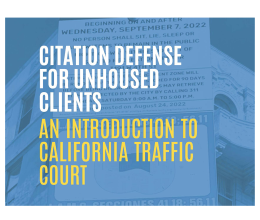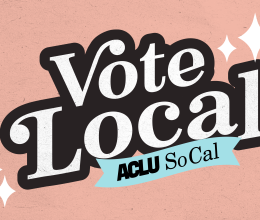
Santa Ana, CA – More than six years after its approval by the Board of Supervisors, Orange County’s Ten-Year Plan to End Homelessness is falling woefully short of meeting key goals and benchmarks, according to a report released today by the ACLU of Southern California (ACLU SoCal).
The 41-page report, “Nowhere to Live: The Homeless Crisis in Orange County & How to End It,” finds that the homeless crisis in the region has grown more acute since the plan was adopted. Today, more than 4,400 people in Orange County experience homelessness on any given night – an increase of 5 percent since 2013 – and the number of people experiencing homelessness over the course of a year has increased by 20 percent, according to the report.
“The situation for many people is critical, and it is getting worse,” said Eve Garrow, ACLU SoCal homelessness policy analyst and advocate. “More people are being pushed into homelessness, and more are living outdoors, without any shelter at all.”
Garrow noted that temporary measures, such as the pending opening of a shelter in an old bus terminal in downtown Santa Ana, serve only a fraction of the homeless population and do not address the larger problems of housing shortages and criminalization of homelessness.
Through a series of interviews with people who are homeless, along with advocates and officials, and by combing through county public records and news reports, the ACLU SoCal discovered that Orange County’s homeless problem is “quite solvable” – people experiencing homelessness comprise only .14 percent of the county’s population – lower than the national average of .18 percent.
The ACLU SoCal report notes that while the Ten-Year Plan is, in many respects, well-conceived, county officials have failed to follow their own blueprint, which recommends helping individuals who are homeless move into “safe and affordable permanent housing as an immediate response to their crisis.”
Instead, the report says, the plan has failed in crucial aspects, including:
- Not enough beds. The county has created enough permanent housing for only between a fourth and a third of chronically homeless people who are sleeping on county streets on any given night. Almost 90 percent of all homeless people in Orange County do not meet the federal definition of chronic homelessness and face four- to eight-year waiting lists for affordable housing – if they can get on the lists, which are usually closed.
- Not enough funding. The county relies on diminishing federal and state funding to solve the problem and allocates very little of its own revenue to build housing and provide services to get people sheltered.
- Not enough relief. The county’s General Relief program, which gives low-income people a little more than $300 a month, is far too low to meet even the most basic needs let alone pay rent in one of the nation’s most expensive counties.
- Not enough humanity. The county, and 33 of its 34 cities, have responded to the crisis by passing and aggressively enforcing ordinances that ban camping, sleeping or resting in public places. The harsh measures fuel homelessness by saddling people with fines, jail time and criminal records that make it even harder for them to access to housing and services. Even worse, tense encounters between homeless individuals and law enforcement can turn deadly, as in the recent fatal shooting of Richard Gene Swihart by Santa Ana police officers.
The report urges county officials to:
- Develop a plan that increases permanent supportive housing for people who are chronically homeless by at least 740 beds.
- Close the county’s housing affordability gap to meet the needs of people who may not be disabled or experiencing long-term homelessness.
- Create a dedicated source of funding – such as a housing trust fund – to pay for permanent supportive and affordable housing.
- Take the lead in decriminalizing homelessness by ending county bans on basic life activities such as sitting, sleeping or camping in public places and by penalizing cities that enforce such bans.
While addressing homelessness is a knotty problem, the report points out that doing nothing could be more costly. Studies show it costs more to jail, treat in emergency rooms and care for individuals who are chronically homeless than it does to house them. And, not coincidentally, the Ten-Year Plan is required by the federal government.
In a place as wealthy as Orange County, the report concludes, the cost of providing permanent housing is not an excuse for inaction. It’s time for the county to fulfill the promise of the Ten-Year Plan and its obligation to its people.





